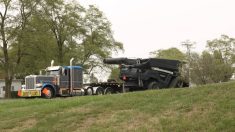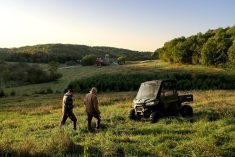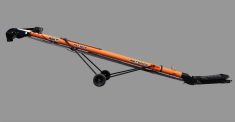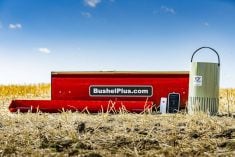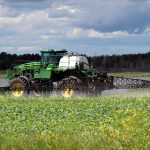The “official” judging team for this year’s Grainews Machinery Challenge included active farmers. But we wondered how our group of test machines might fit into our readers’ farming operations. The best way to answer that, we thought, was to put a few of them in the drivers’ seats. So, Grainews held a contest in the run-up to Ag In Motion. To win a chance to be a guest judge, we asked you, our readers, to send in photos of the loader you’re using on your farm. Once we had the entries, we made random selections. The winners were invited to join our judging panel and evaluate the machines. (We chose three judges, but judge No. 3 was unable to come.)
Read Also

Claas brings 1000 Series SP forage harvesters to Canada
In mid-August, Claas unveiled its new line of Jaguar forage harvesters at an event in Visalia, California, deep in the heart of that state’s dairy region.
The two farmer judges who joined in the testing were Jim Latrace and Dave Smith.
Our random selections worked well. These two farmers run very different farm operations and are at very different points in their careers. Latrace and his family operate a seed farm near Lumsden, Saskatchewan. He is a relatively young farmer with school-age children.
Dave Smith and his wife, Susan, have a cattle operation near Lockwood, Saskatchewan. Although they’ve downsized in recent years, the Smiths are still running a cattle herd. Dave is 77, and the Smiths are getting ready to retire.
Not surprisingly, we ended up with two very different points of view.
Kubota SSV 75
Of course, skid steers aren’t new to these farmers. Dave Smith said he didn’t really have a lot of use for one on his farm. “I feed the cows out in the field,” he said, so he doesn’t often need a machine for chores like cleaning manure out of a barn.
But after some seat time, he warmed up to this Kubota, finding it easy to operate and having no trouble scrambling over the front of it to get into the cab. He ended up thinking of a lot of chores this machine could do on his farm — with the exception of spreading manure.
Latrace was no stranger to skid steers either, so he took time to notice some features specific to this model. He really appreciated that the front window could be locked open. Without this feature, he’s found it difficult to communicate with people outside while operating similar machines on his farm. “To be able to lock it open is awesome,” he said.
Latrace also noticed the access hole in the floor of the cab that makes it easy for the operator to sweep mud out. “I love that idea,” Latrace said. “That was a cool option that I’ve never seen in another skid steer.”
Read more about the Kubota SSV 75.
Giant V761T
As a seed grower, Latrace felt that the Giant “had the most use in my kind of world because it was small.” While he could always find uses for the longer booms on the Dieci or the Merlo, the Giant’s boom could do everything Latrace actually needs to do.
He liked the Giant’s centre-mounted boom configuration. “When you’re sitting in the center, you didn’t feel like you had blind spots,” he said. Although he did point out that over time, he could probably get used to any of the machines.
Latrace thought of a lot of different jobs around the yard where he could put the Giant to work, including mowing, blowing snow and rototilling.
Initially, Smith was a little uncomfortable with the different control layout in the cab. However, he admitted that might not be a problem if he actually owned the machine. “After you got used to it, it would be really good,” he said.
He found the steering response a little slow when the machine was standing still.
The Giant’s active braking system took a little getting used to for both Latrace and Smith. “When you let the throttle off, the hydrostatic stopped you,” Latrace said. The machine would come to a quick stop, while most tractors coast to a stop. However, Latrace said, “You get used to it pretty quick.”
Read more about the Giant V761T.
Dieci Agri Tech 35.7 VS
Smith thought the longer booms on both the Dieci and the Merlo might make it easier to see while you’re loading pallets. He could see a lot of uses for that extra reach, especially when leveling ground. “You could talk yourself into buying one,” he said, looking a little wistful. Although, he did admit that for most of his on-farm work extended reach wasn’t too important.
While some of the testers found the Dieci a little difficult to get in and out of, Smith had no trouble at all. He felt the grab handles were in exactly the right place. “Even 77-year old cowboys can get into it,” he said.
Smith also noticed that there was no way to hold the cab door open in the wind while working. But he found this machine to be really nice to drive. And, he pointed out, despite the lower price tag, “It did most of what the Merlo did.”
Latrace agreed with that sentiment, and said that if was buying one of these machines, price would be a major factor.
Read more about the Dieci Agri Tech 35. VS.
Merlo MF 40.9
“This is the one with the cool factor,” Latrace said. Both Smith and Latrace were very impressed with this machine, but they also thought the higher MSRP would be a hurdle. They liked the Merlo’s host of features, ranging from the long boom to a well-placed grease gun holder.
Latrace found exiting the Merlo’s cab a little awkward. “I need a step to come out, because I always get out of the cab facing out.” (This wouldn’t be a problem if he bought the machine. After a few seconds examining the step, in true farmer style, Latrace had figured out exactly how he’d “fix” the step so it worked for him.)
However, Smith took the opposite view. “The steps have to be where they are because you want them inside the tire width,” he said. He liked the low-slung cab, and the fact that there were only two steps up instead of three.
Both thought the price of the Merlo might lead them to buy a cheaper machine, but both talked a lot about the impressive extra capabilities it could bring to their farms. For example, Latrace said if he had a boom as long as the Merlo’s boom, he’d use it as a scaffold. If he owned it, he said, he’d find things to do with it. “You’d use it everyday,” he said. He especially liked the idea of having remote control from the bucket, for work-alone jobs. “That would be pretty sweet.”
“I want one of these just because it’s cool,” Latrace said when he climbed out of the machine after his test drive. However, later on, with a little time to reflect on the options, Latrace thought that for the $200,000-plus sticker price, he also had the option of buying a couple of specialized machines that did exactly what he needed to do.
Read more about the Merlo MF 40.9.
Overall
We asked the farmer judges if this experience would change their minds the next time they buy machinery on their farms.
Smith isn’t in a place in his career where he’s planning a big machinery purchase right now. “If you’ve got cows, everything’s economy,” Smith told us. “That’s why I don’t have much machinery.”
Latrace, however, is actively looking for new machinery solutions for his farm. “I hadn’t run four-wheel steering much before,” he told us, and that feature on the telehandlers impressed him. “As a seed operation, I almost need more forklift than loader tractor.”
While he enjoyed trying them out, Latrace believes the telehandlers are just a little too big (and expensive) for what he actually needs to do on his farm. “In the construction world, the first question that everybody asks is ‘how soon can you do this?’ In the ag world, the first question that everybody asks is ‘how much does it cost?’”
In the end, one discussion seemed to exemplify the range of views different farmers have on machines, and that really came through with our farmer panel reviews. Latrace was a little disappointed that none of the four machines we had available had good radios. On his farm, the radio is “always on” in their machines. Smith laughed. In his cabs, the radio is “always off.”




